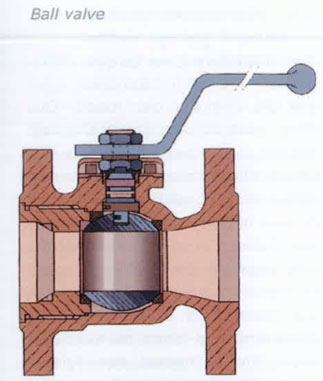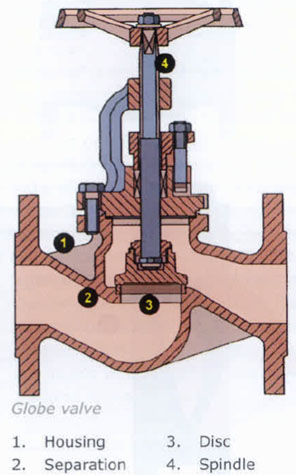Valve used on ships - ball and stop valves
Valve used on ships - ball and stop valves
Continuing an important topic - valves used on ships. We have already talked about gate valves and butterfly valves. Another popular valve type widely used on land is
Ball valve
 Like the butterfly valve, the ball valve is a “quarter turn” valve. In some ways they are similar in design, just as simple and reliable. Small sizes - up to DN100 - have a floating ball between the PTFE seats. The body is made of steel, stainless steel or brass, plated with a layer of nickel or chrome.
Like the butterfly valve, the ball valve is a “quarter turn” valve. In some ways they are similar in design, just as simple and reliable. Small sizes - up to DN100 - have a floating ball between the PTFE seats. The body is made of steel, stainless steel or brass, plated with a layer of nickel or chrome.
Due to their design, ball valves can operate in a wide variety of media at high pressures and temperatures. Many models have so-called. A blow-out stem that cannot be pushed out by internal line pressure. However, if you intend to use a PTFE-seated ball valve at elevated temperatures, you should always check the maximum working pressure at that temperature against the manufacturer's tables. When dealing with hot steam, hot oil, or boiling water, it's always best to play it safe.
The straight-through design guarantees minimal pressure loss. Most models are full bore, although reduced bore (bore) ball valves are sometimes used for economy reasons.
Ball valves are mainly used for pressures over 25 bar, and for hydraulic systems where pressures can exceed 150 bar, this is the main option. In general, it can be said that up to nominal size DN100 (internal diameter approx. 100 mm) ball valves are the best choice both technically and economically. Larger sizes greatly increase the weight and require a special turning mechanism, which makes such valves less attractive.
A special area of application for ball valves is the fuel system. Fireproof valves equipped with antistatic protection must be used here.
Small ball valves are ideal for electrically or pneumatically actuated remote control systems with very fast response times.
Stop valve
Another name is a control valve (sometimes in translation texts it is mistakenly called a ball valve ). This is the faucet with a lamb, familiar to all of us from childhood, which must be unscrewed several turns so that the water flows in full flow.
 It is also arranged simply and reliably, like everything else on ships (ideally). Since these valves were first used in steam engines at the dawn of the industrial era, their classic design has not changed. Housing with a horizontal baffle that has a round hole (seat). It is closed by a disc that moves up and down on a threaded spindle. The disc is connected to the spindle so that it can turn and wobble slightly, which ensures a tight fit to the seat and no turning when tightening.
It is also arranged simply and reliably, like everything else on ships (ideally). Since these valves were first used in steam engines at the dawn of the industrial era, their classic design has not changed. Housing with a horizontal baffle that has a round hole (seat). It is closed by a disc that moves up and down on a threaded spindle. The disc is connected to the spindle so that it can turn and wobble slightly, which ensures a tight fit to the seat and no turning when tightening.
If the disc is not attached to the spindle, we get an ordinary check valve.
Body and cover materials - cast iron, bronze, stainless steel, depending on the type of pumped liquid.
A distinctive feature of these valves is that the flow in them changes direction by 180 °, therefore the pressure loss is greater than that of other types of valves - ball valves, dampers, gates.
A remarkable property of control valves is that thanks to their metal-to-metal seat they can be used in any medium, at high temperatures and pressures. The tightness of the closure is ensured by the correct selection of the material for the seat ring seal. As engineers of the old school explained “on the fingers” - the more force you put on the spindle to close the valve, the more correct your choice was!
The best installation position is horizontal with the flow trying to raise the valve disc. In theory, to fully open such a valve, it is enough to raise the disc by 1/4 of the hydraulic diameter: 25 mm for DN100, in practice a little more.
For steam applications, check valves are the primary, if not the only choice. They are used precisely as shut-off valves ; they should not be confused with sometimes installed control (control) valves . With a similar design, the control valve never completely blocks the flow during normal operation.
Applications on ships - cooling water, steam, clean water.
 +7 (812) 4-673-673
+7 (812) 4-673-673